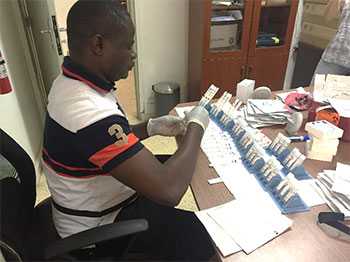Expanding the Ebola Control Tool Box: A New Rapid Diagnostic Test in Guinea
The Bottom Line
CHALLENGE: Standard Ebola testing took 24 hours to give results and was available in a few facilities in Guinea, meaning patients had to travel far and wait days for results. The length of time it took to identify those infected with Ebola, delayed treatment and allowed the virus to spread.
SOLUTION: CDC and the Guinea Ministry of Health saved lives by implementing the innovative Ebola rapid diagnostic test. Testing is now possible at regular local health facilities, and the results take just 30 minutes. Isolating and treating Ebola patients, as well as contact tracing for others who may also be infected, helped break the chains of transmission.
Results change lives
During the Ebola epidemic, timely test results changed lives. However, it was difficult to test people exposed to Ebola since laboratories in Guinea had limited supplies and few trained staff. Patients from remote areas had to leave their families and travel long distances to an Ebola Treatment Unit (ETU), where trained lab workers could safely draw their blood and test using standard polymerase chain reaction (PCR)—a method which required 24 hours to obtain results.
These barriers made people reluctant to get tested. Some community members were afraid when they saw health workers approaching and, “would hide in the homes of relatives to avoid being tested,” says CDC epidemiologist Michele Balihe, who worked on the outbreak in Guinea. “It’s understandable that no one wanted to travel two hours from home to an ETU and wait 24 hours for test results.”
Healthcare workers in the field desperately needed a safe, yet quick way to determine if someone was infected with Ebola.

A testing innovation
Promising tools, like Rapid Diagnostic Tests (RDT), were under review by the Food and Drug Administration (FDA), but not yet approved for routine use. RDTs can be used in the field, and are more versatile than the gold-standard PCR tests for Ebola. The OraQuick Ebola RDT provided a quick, finger-stick blood test or oral swab test that yielded results in 30 minutes.
The rapid test was approved in July 2015 using FDA’s Emergency Use Authorization—a special rule that allow healthcare workers to use unapproved, but potentially life-saving devices or drugs during a health crisis.
Armed with the new RDT, CDC and the Guinea Ministry of Health (MoH) launched a pilot program to train healthcare workers how and when to use the screening test. By June 2016, CDC, the MoH, and partners trained more than 200 healthcare professionals, and administered more than 12,000 RDTs.
Protecting against future health threats
The RDT was a game changer. Instead of traveling to a far-off ETU, people could be conveniently tested at nearby health facilities, which helped to quickly identify and isolate infected people, and ultimately brought the outbreak under control.
This work is part of CDC’s commitment to the Global Health Security Agenda, which seeks to improve the world’s ability to prevent, detect, and respond to infectious disease threats.
CDC’s assistance and collaboration with the MoH and partners, increased Guinea’s trained healthcare workforce and provided it with new diagnostic tools. Guinea faces a continuing risk of Ebola flare-ups, but the RDT program will provide rapid detection and response to any future cases. Though the situation has improved, more work needs to be done, including expanding RDT use. The RDT program, as well as other efforts by international partners, are strengthening Guinea’s health system to fend off future public health threats.
About This Story
This story illustrates Guinea’s commitment to meeting specific targets of the Global Health Security Agenda (GHSA):
- National Laboratory System: Real-time bio-surveillance with a national laboratory system and effective modern point-of-care and laboratory-based diagnostics.
The GHSA strives to improve the world’s ability to prevent, detect, and respond to infectious disease threats. Today, CDC is partnering with 31 countries around the world to reach the goals of the GHSA.
- Page last reviewed: September 27, 2016
- Page last updated: September 27, 2016
- Content source:


 ShareCompartir
ShareCompartir